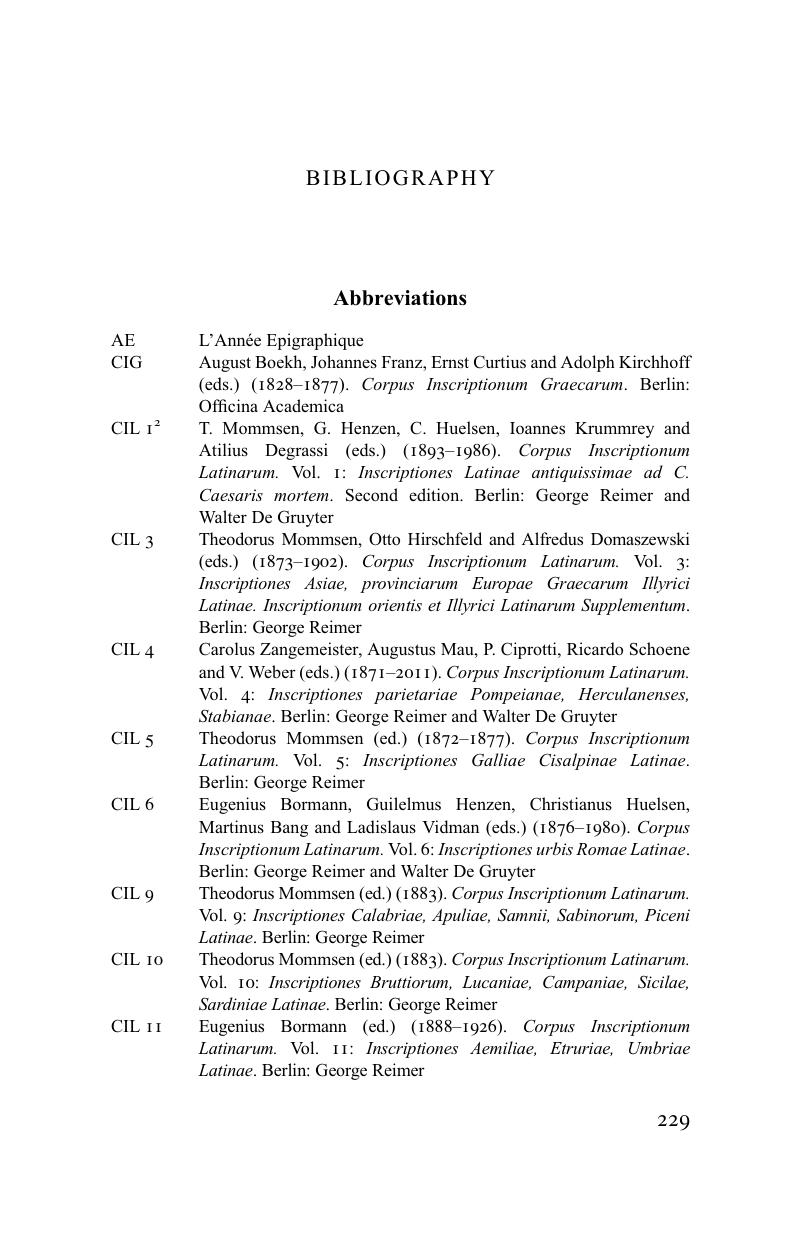Book contents
- Oscan in the Greek Alphabet
- Cambridge Classical Studies
- Oscan in the Greek Alphabet
- Copyright page
- Contents
- Tables
- Book part
- Conventions and readings
- Glossary
- 1 Introduction
- 2 Vowels
- 3 Consonants
- 4 Influence from the Oscan alphabet
- 5 Conclusions
- 6 Oscan words discussed in this book
- Bibliography
- Index of words
- Index of subjects
- References
Bibliography
Published online by Cambridge University Press: 05 February 2016
- Oscan in the Greek Alphabet
- Cambridge Classical Studies
- Oscan in the Greek Alphabet
- Copyright page
- Contents
- Tables
- Book part
- Conventions and readings
- Glossary
- 1 Introduction
- 2 Vowels
- 3 Consonants
- 4 Influence from the Oscan alphabet
- 5 Conclusions
- 6 Oscan words discussed in this book
- Bibliography
- Index of words
- Index of subjects
- References
Summary

- Type
- Chapter
- Information
- Oscan in the Greek Alphabet , pp. 229 - 243Publisher: Cambridge University PressPrint publication year: 2016
References
Bibliography
L’Année Epigraphique
Boekh, August, Franz, Johannes, Curtius, Ernst and Kirchhoff, Adolph (eds.) (1828–1877). Corpus Inscriptionum Graecarum. Berlin: Officina Academica
Mommsen, T., Henzen, G., Huelsen, C., Krummrey, Ioannes and Degrassi, Atilius (eds.) (1893–1986). Corpus Inscriptionum Latinarum. Vol. 1: Inscriptiones Latinae antiquissimae ad C. Caesaris mortem. Second edition. Berlin: George Reimer and Walter De Gruyter
Mommsen, Theodorus, Hirschfeld, Otto and Domaszewski, Alfredus (eds.) (1873–1902). Corpus Inscriptionum Latinarum. Vol. 3: Inscriptiones Asiae, provinciarum Europae Graecarum Illyrici Latinae. Inscriptionum orientis et Illyrici Latinarum Supplementum. Berlin: George Reimer
Zangemeister, Carolus, Mau, Augustus, Ciprotti, P., Schoene, Ricardo and Weber, V. (eds.) (1871–2011). Corpus Inscriptionum Latinarum. Vol. 4: Inscriptiones parietariae Pompeianae, Herculanenses, Stabianae. Berlin: George Reimer and Walter De Gruyter
Mommsen, Theodorus (ed.) (1872–1877). Corpus Inscriptionum Latinarum. Vol. 5: Inscriptiones Galliae Cisalpinae Latinae. Berlin: George Reimer
Bormann, Eugenius, Henzen, Guilelmus, Huelsen, Christianus, Bang, Martinus and Vidman, Ladislaus (eds.) (1876–1980). Corpus Inscriptionum Latinarum. Vol. 6: Inscriptiones urbis Romae Latinae. Berlin: George Reimer and Walter De Gruyter
Mommsen, Theodorus (ed.) (1883). Corpus Inscriptionum Latinarum. Vol. 9: Inscriptiones Calabriae, Apuliae, Samnii, Sabinorum, Piceni Latinae. Berlin: George Reimer
Mommsen, Theodorus (ed.) (1883). Corpus Inscriptionum Latinarum. Vol. 10: Inscriptiones Bruttiorum, Lucaniae, Campaniae, Sicilae, Sardiniae Latinae. Berlin: George Reimer
Bormann, Eugenius (ed.) (1888–1926). Corpus Inscriptionum Latinarum. Vol. 11: Inscriptiones Aemiliae, Etruriae, Umbriae Latinae. Berlin: George Reimer
Hirschfeld, Otto, Zangemeister, Carolus, Domaszewski, A., Bohn, O., Stein, E. and Volkmann, I. (eds.) (1899–1943). Corpus Inscriptionum Latinarum. Vol. 13: Inscriptiones trium Galliarum et Germaniarum Latinae. Berlin: George Reimer and Walter De Gruyter
Dessau, Hermannus and Wickert, Lotharius (eds.) (1887–1933). Corpus Inscriptionum Latinarum. Vol. 14: Inscriptiones Latii veteris Latinae. Berlin: George Reimer and Walter De Gruyter
Pokorny, Julius (1959). Indogermanisches etymologisches Wörterbuch. Bern and Munich: Francke Verlag
Edson, Carolus, Papazoglu, Fanula, Milin, Milena and Ricl, Marijana (eds.) (1972–1999). Inscriptiones Graecae Epiri, Macedoniae, Thraciae, Scythiae. Berlin: Walter De Gruyter
Kaibel, George and Lebegue, Albert (eds.) (1890). Inscriptiones Graecae Siciliae et Italiae. Additis Graecis Galliae Hispaniae Britanniae Germaniae Inscriptionibus. Berlin: George Reimer
Rix, Helmut and Kümmel, Martin (2001). Lexikon der indogermanischen Verben. Second edition. Wiesbaden: Dr. Ludwig Reichert
Simone, Carlo de and Marchesini, Simona (eds.) (2002). Monumenta Linguae Messapicae. Wiesbaden: Dr Ludwig Reichert Verlag
Wodtko, Dagmar, Irslinger, Britta and Schneider, Carolin (2008). Nomina im Indogermanischen Lexikon. Heidelberg: Universitätsverlag Winter
Supplementum Epigraphicum Graecum

